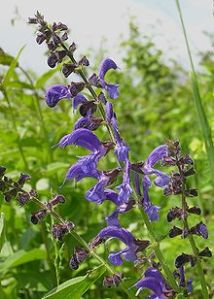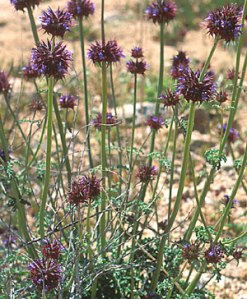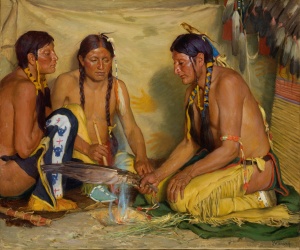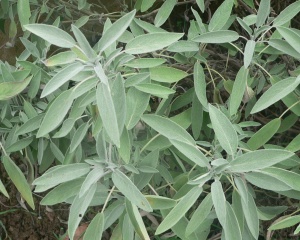Sage is a lovely and important medicinal herb, also a sacred one. I grow several varieties and am always adding more. My garden is never without the traditional garden sage, salvia officinalis. There are some variations of this kind, the fuzzy leafed and tricolored sage, but I still like the good old standby that came to America with the early colonists. You may not realize how many varieties of sage are native to the New World, and their many uses, medical and spiritual. Scarlet sage attracts hummingbirds and is striking in the border, but there are many beautiful varieties.
Sage (Salvia) Common name: Wild Sage, Meadow Sage (S. pratensis) Scarlet Sage or Texas Sage (Salvia coccinea), Chia Sage grows throughout southern Canada and the United States, the very important chia (S. columbriae) in Arizona, Utah, Nevada, and California.

From Field Guide to Medicinal Wild Plants by Bradford Angier:
I love this book, given to me by my dear grandmother who lived to be 99 and a half. Mr. Angier has also written other volumes.
I love this book, given to me by my dear grandmother who lived to be 99 and a half. Mr. Angier has also written other volumes.
Sage is a fuzzy perennial with soft, downy hairs. One characteristic is that, when a bunch is wadded together, it clings to itself, remaining a compact mass. The erect stems are greyish with down and have, on pubescent stalks toward their bases, up to about 18-inch-long leaves.
Several wheels of tiny blue or whitish, and sometimes reddish, flowers grow in whorls of four to eight, depending on the particular species. The plants have an easily recognized strong, unique, aromatic odor.
 The chia variety, a distinctive annual springing up in the Southwest at the start of the late fall rains and an Indian standby, is a rough sage with deeply incised, coarse, usually hairy, dark-green leaves that grow mostly close to the ground. Three or so whirls of small blue flowers circle, mint like, in separated densities above prickly, dark-red, leafy bracts. These mature into seed-filled pods that remain like skeletons when the rest of the plant has withered, not giving the winds enough purchase to blow them free, and leaving them for the Indians to gather.
The chia variety, a distinctive annual springing up in the Southwest at the start of the late fall rains and an Indian standby, is a rough sage with deeply incised, coarse, usually hairy, dark-green leaves that grow mostly close to the ground. Three or so whirls of small blue flowers circle, mint like, in separated densities above prickly, dark-red, leafy bracts. These mature into seed-filled pods that remain like skeletons when the rest of the plant has withered, not giving the winds enough purchase to blow them free, and leaving them for the Indians to gather.
The seeds of the Texas sage (S. coccinea) are oblong, angular, or bowed, and 2 to 3 millimeters in size. Those of the annual scarlet sage take two or three weeks to emerge.
 The medicinal part of the plant in general is the leaves, harvested during the flowering period in June and July. In the case of the chia, the vital part is the seeds, which are gathered from the then nearly dead annual in July.
The medicinal part of the plant in general is the leaves, harvested during the flowering period in June and July. In the case of the chia, the vital part is the seeds, which are gathered from the then nearly dead annual in July.
Steeped like tea and in the same proportions, sage tea was slightly tonic and quieting to a disordered stomach. It’s peculiar but pleasant odor was retained in the beverage by the warmish, somewhat bitter aroma of the extracted volatile oil. It was said to benefit a ticklish and irritated throat, to quiet and expel bothersome gas, and assist the liver, kidneys, and gallbladder. Regarded in many regions as effective in treating sore throat, accompanied by fever, cankers, sore gums, mouth ulcers, and swollen tonsils, and as an effective gargle. The juice from bruised fresh leaves was credited with helping to remove warts, also pressed into service for sores, cuts, and wounds. The Indians made a salve of the crushed fresh leaves and edible lard for these purposes. Some tribes made salve from the roots of wild sage (S. lyrata).
A refreshing drink for hot weather was made by mixing chia seeds with cool water, each seed becoming separately suspended in its own white, mucilaginous cloudiness. The white, gray, and brown seeds are so nutritious that a teaspoonful was regarded as enough to sustain an Indian for a day on a forced journey.
 Native American Smudging Ceremony: From The Smudging Ceremony
Native American Smudging Ceremony: From The Smudging Ceremony
"Our Native elders have taught us that before a person can be healed or heal another, one must be cleansed of any bad feelings, negative thoughts, bad spirits or negative energy - cleansed both physically and spiritually.,,Native people throughout the world use herbs to accomplish this. One common ceremony is to burn certain herbs, take the smoke in one's hands and rub or brush it over the body. Today this is commonly called "smudging." In Western North America the three plants most frequently used in smudging are sage, cedar, and sweetgrass.
Many varieties of sage have been used in smudging. The botanical name for "true" sage is Salvia (e.g. Salvia officinalis, Garden Sage, or Salvia apiana, White Sage). It is interesting to note that Salvia comes from the Latin root salvare, which means "to heal." There are also varieties of sage which are of a species separate from Salvin Artemusia. Included here are sagebrush (e.g. Artemisia californica) and mugwort (Artemisia vulgaris). We have seen both Salvia and Artemisia sub-species used in smudging."
I've discussed salvia officinalis (pictured below) in another post, but briefly: Salvia officinalis (called garden or common sage) is a perennial, evergreen subshrub, with woody stems, grayish leaves, and blue to purplish flowers. A member of the family Lamiaceae, sage is native to the Mediterranean region, though it has naturalized in many places throughout the world.
"Native Americans consider sage, cedar, sweetgrass and tobacco as the Four Sacred Herbs. Sage is found across North America, with white sage being the most potent and gray sage found in many northern areas where the gray will not over-winter. Cedar (Eastern red cedar) (Eastern white cedar) and sweetgrass also are indigenous to this continent. Tobacco can be found in many forms; however for this ceremony Nicotiana Rustica, or a similar dried tobacco leaf, native to America is preferred."


No comments:
Post a Comment